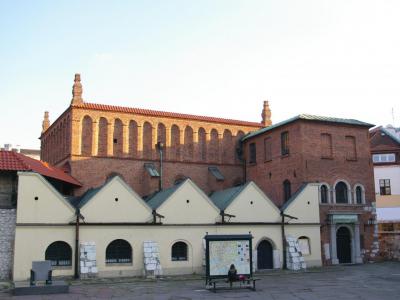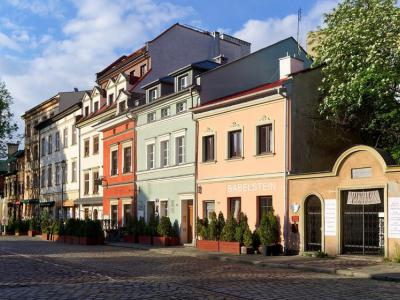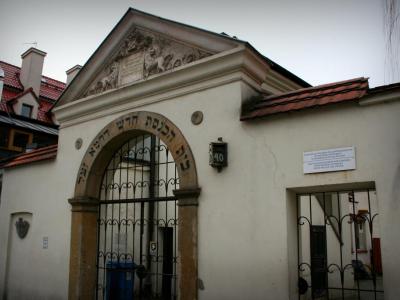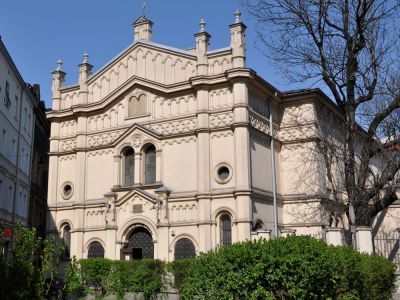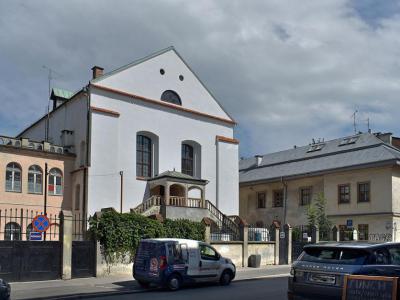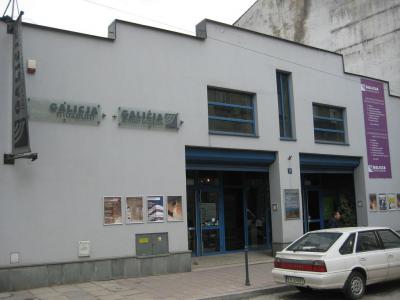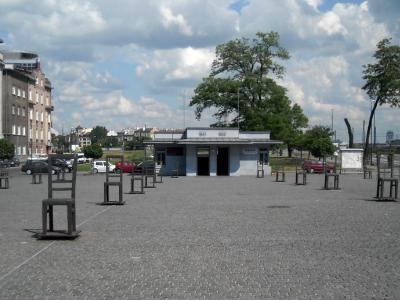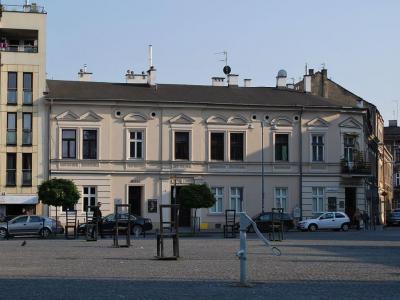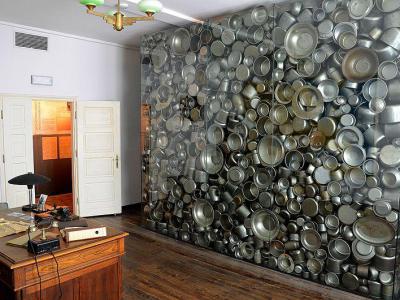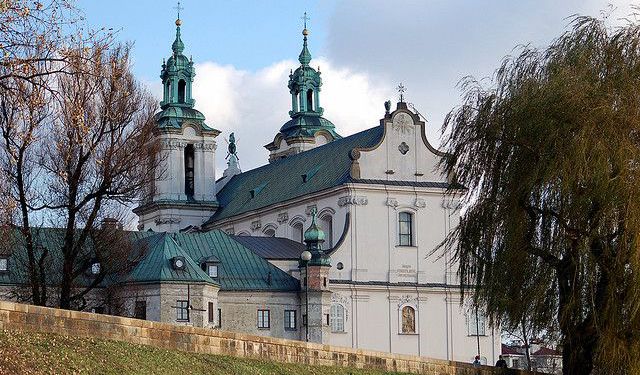
Jewish Heritage Tour in Krakow (Self Guided), Krakow
The Jewish community has been an integral part of Krakow since the late 13th century. On the eve of World War II, there were 60,000 Jews living in the city, mostly in the historic Kazimierz neighborhood, which accounted for a quarter of the local population. The old town square in Kazimierz was the center of Jewish life.
During the war, the Nazis separated ethnic Jews from the rest of Cracovians into a ghetto in an attempt to “finally solve the Jewish question.” Most of the local Jews were sent to death camps never to return. Still, despite such devastation, several Jewish establishments in the area survived the ordeal and today stand to tell the story of Krakow's Jews.
The Old Synagogue, one of the oldest in Europe, is a testament to centuries of Jewish life in the city. Szeroka Street, the main square in Kazimierz, is lined with charming buildings and cafes, providing a glimpse into the area's vibrant Jewish culture.
Ariel Jewish Restaurant is a popular spot where you can savor traditional Jewish cuisine, while the Remah Synagogue and Cemetery, with its historic tombstones, is a solemn reminder of the community's past.
The Reformed Temple Synagogue, or Synagoga Tempel, showcases stunning architecture and, apart from being a house of worship, today serves as a cultural center. Another temple of note and architectural gem in the vicinity is the Izaak Synagogue.
For a deeper understanding of Jewish heritage, visit the Galicia Jewish Museum, which explores the Jewish history of the region through exhibitions and artifacts. Nearby, Ghetto Heroes Square pays homage to the Jews who suffered during World War II.
The Eagle Pharmacy is a poignant site in the former Jewish ghetto, where a pharmacist helped save lives during the Holocaust. And, of course, don't miss Oscar Schindler's Factory, which tells the story of Schindler's efforts to rescue Jews during the war.
This trip is bound to give you a sobering experience that is most likely to stay with you for the rest of your life. By visiting these sites and learning about the Jewish history of Krakow, you ensure that this rich heritage is not forgotten and will be shared with generations to come.
During the war, the Nazis separated ethnic Jews from the rest of Cracovians into a ghetto in an attempt to “finally solve the Jewish question.” Most of the local Jews were sent to death camps never to return. Still, despite such devastation, several Jewish establishments in the area survived the ordeal and today stand to tell the story of Krakow's Jews.
The Old Synagogue, one of the oldest in Europe, is a testament to centuries of Jewish life in the city. Szeroka Street, the main square in Kazimierz, is lined with charming buildings and cafes, providing a glimpse into the area's vibrant Jewish culture.
Ariel Jewish Restaurant is a popular spot where you can savor traditional Jewish cuisine, while the Remah Synagogue and Cemetery, with its historic tombstones, is a solemn reminder of the community's past.
The Reformed Temple Synagogue, or Synagoga Tempel, showcases stunning architecture and, apart from being a house of worship, today serves as a cultural center. Another temple of note and architectural gem in the vicinity is the Izaak Synagogue.
For a deeper understanding of Jewish heritage, visit the Galicia Jewish Museum, which explores the Jewish history of the region through exhibitions and artifacts. Nearby, Ghetto Heroes Square pays homage to the Jews who suffered during World War II.
The Eagle Pharmacy is a poignant site in the former Jewish ghetto, where a pharmacist helped save lives during the Holocaust. And, of course, don't miss Oscar Schindler's Factory, which tells the story of Schindler's efforts to rescue Jews during the war.
This trip is bound to give you a sobering experience that is most likely to stay with you for the rest of your life. By visiting these sites and learning about the Jewish history of Krakow, you ensure that this rich heritage is not forgotten and will be shared with generations to come.
How it works: Download the app "GPSmyCity: Walks in 1K+ Cities" from Apple App Store or Google Play Store to your mobile phone or tablet. The app turns your mobile device into a personal tour guide and its built-in GPS navigation functions guide you from one tour stop to next. The app works offline, so no data plan is needed when traveling abroad.
Jewish Heritage Tour in Krakow Map
Guide Name: Jewish Heritage Tour in Krakow
Guide Location: Poland » Krakow (See other walking tours in Krakow)
Guide Type: Self-guided Walking Tour (Sightseeing)
# of Attractions: 10
Tour Duration: 2 Hour(s)
Travel Distance: 3.1 Km or 1.9 Miles
Author: ellen
Sight(s) Featured in This Guide:
Guide Location: Poland » Krakow (See other walking tours in Krakow)
Guide Type: Self-guided Walking Tour (Sightseeing)
# of Attractions: 10
Tour Duration: 2 Hour(s)
Travel Distance: 3.1 Km or 1.9 Miles
Author: ellen
Sight(s) Featured in This Guide:
- Old Synagogue
- Szeroka Street
- Ariel Jewish Restaurant
- Remah Synagogue and Cemetery
- Reformed Temple Synagogue (Synagoga Tempel)
- Izaak Synagogue
- Galicia Jewish Museum
- Ghetto Heroes Square
- Eagle Pharmacy
- Oscar Shindler's Factory
1) Old Synagogue
The Old Synagogue (Synagoga Stara), an Orthodox Jewish place of worship, graces the Kazimierz district of Kraków. Known as the Alta Shul in Yiddish, it stands as Poland's oldest remaining synagogue and ranks among the most cherished symbols of Jewish architectural heritage in Europe. Until the onset of the German invasion in 1939, it held paramount significance as one of the city's primary synagogues, serving as the central hub for religious, communal, and organizational activities within the Kraków Jewish community.
The Synagogue's construction date varies across sources, pointing to either 1407 or 1492. In 1570, the original edifice underwent reconstruction under the careful guidance of Italian architect Mateo Gucci. This refurbishment included fortifications such as an attic wall equipped with loopholes, high-set windows for defense, and robust masonry walls supported by hefty buttresses—a design inspired by military architecture. This makes the Old Synagogue a rare survivor, embodying the concept of a Polish fortress synagogue.
World War II witnessed the synagogue's utter devastation and plunder at the hands of the Germans. Its artistic treasures and Jewish artifacts were pillaged, and it suffered the indignity of being repurposed as a warehouse during the occupation. In 1943, its walls bore witness to the execution of 30 Polish hostages. However, the Old Synagogue was restored between 1956 and 1959 and now serves as a museum. Operating under the Historical Museum of Kraków, it holds a special focus on the city's Jewish heritage. The exhibitions are thematically organized to explore aspects such as birth, prayer rituals, dietary practices, divorce, and death.
The Synagogue's construction date varies across sources, pointing to either 1407 or 1492. In 1570, the original edifice underwent reconstruction under the careful guidance of Italian architect Mateo Gucci. This refurbishment included fortifications such as an attic wall equipped with loopholes, high-set windows for defense, and robust masonry walls supported by hefty buttresses—a design inspired by military architecture. This makes the Old Synagogue a rare survivor, embodying the concept of a Polish fortress synagogue.
World War II witnessed the synagogue's utter devastation and plunder at the hands of the Germans. Its artistic treasures and Jewish artifacts were pillaged, and it suffered the indignity of being repurposed as a warehouse during the occupation. In 1943, its walls bore witness to the execution of 30 Polish hostages. However, the Old Synagogue was restored between 1956 and 1959 and now serves as a museum. Operating under the Historical Museum of Kraków, it holds a special focus on the city's Jewish heritage. The exhibitions are thematically organized to explore aspects such as birth, prayer rituals, dietary practices, divorce, and death.
2) Szeroka Street
Surrounded by old synagogues, mansions and some of Krakow’s oldest buildings, the Szeroka Street is a must visit when you tour the Kazimierz. More of a square than a street, the Szeroka was once a village of Bawół, which was incorporated into Kazimierz after the town centre was formed in 1340. Some of its buildings date back to the early 14th and 15th century whose edifices still tell tales of their respective eras.
Buildings that must not be missed here are the two very old synagogues, the Old Synagogue, established in the late 15 and early 16th century and the Remuh Synagogue, which also has a cemetery attached to it.
On the northern side of the Szeroka stands a ritual basin which receives its water from a spring. Called the Mikveh, it exists since the late 16th century although the structure underwent several reconstructions over the years. A walk around the Street will surely add to the number of interesting places that this place has to offer.
A rather recent addition to the place has been the string of cafes and restaurants in the area. Sticking to Jewish traditions, it is a great place to sit and experience the authentic Jewish way of dining and grabbing some delicious knick knacks.
Buildings that must not be missed here are the two very old synagogues, the Old Synagogue, established in the late 15 and early 16th century and the Remuh Synagogue, which also has a cemetery attached to it.
On the northern side of the Szeroka stands a ritual basin which receives its water from a spring. Called the Mikveh, it exists since the late 16th century although the structure underwent several reconstructions over the years. A walk around the Street will surely add to the number of interesting places that this place has to offer.
A rather recent addition to the place has been the string of cafes and restaurants in the area. Sticking to Jewish traditions, it is a great place to sit and experience the authentic Jewish way of dining and grabbing some delicious knick knacks.
3) Ariel Jewish Restaurant
Nowadays, Kosher culture is as much part of the Krakow culinary scene as it is part of the centuries-old Jewish tradition. Amid the variety of Jewish restaurants lining Szeroka Street there is one with reputation of delivering a truly unique dinning experience.
Situated in the heart of Kazimierz, on Jewish Square, amid five synagogues, the place is called Ariel – in honor of one of the four archangels, Uriel (the "Light of God"). Perhaps it is due to this Old Testament association and/or blessing from God that the local food – borscht, cabbage salads and Russian-style pierogies – are particularly delicious.
The interior is quite typical of the neighborhood, decorated in a charmingly cluttered style. The green room with a fireplace is cozy and full of character – resembling a 16th-century Jewish tenement house – manifested in an eclectic mix of historic paintings and vintage stuff.
In addition to six indoor dining halls laden with antiques and heirlooms from the past, the restaurant also provides outdoor seating in summer. Prices vary between moderate and not so.
If you care for live music, look no further, as you will fill find plenty of it at Ariel. In fact, live klezmer music is a popular lure for tourists here, albeit somewhat costly. In spring and summer the gigs are on everyday, but in winter you may have to call in advance or check their website to find out. Either way reservations are highly recommended. A gift shop and apartment rentals are also available.
Situated in the heart of Kazimierz, on Jewish Square, amid five synagogues, the place is called Ariel – in honor of one of the four archangels, Uriel (the "Light of God"). Perhaps it is due to this Old Testament association and/or blessing from God that the local food – borscht, cabbage salads and Russian-style pierogies – are particularly delicious.
The interior is quite typical of the neighborhood, decorated in a charmingly cluttered style. The green room with a fireplace is cozy and full of character – resembling a 16th-century Jewish tenement house – manifested in an eclectic mix of historic paintings and vintage stuff.
In addition to six indoor dining halls laden with antiques and heirlooms from the past, the restaurant also provides outdoor seating in summer. Prices vary between moderate and not so.
If you care for live music, look no further, as you will fill find plenty of it at Ariel. In fact, live klezmer music is a popular lure for tourists here, albeit somewhat costly. In spring and summer the gigs are on everyday, but in winter you may have to call in advance or check their website to find out. Either way reservations are highly recommended. A gift shop and apartment rentals are also available.
4) Remah Synagogue and Cemetery
The Remah Synagogue, constructed during the 16th century, stands as the smallest of Kraków's historical synagogues within the Kazimierz district. It takes its name from Rabbi Moses Isserles, also known as ReMA, who lived from c. 1525 to 1572. ReMA gained renown for composing a series of commentaries and supplementary texts that complemented Rabbi Yosef Karo's Shulchan Aruch, incorporating Ashkenazi customs and traditions. At present, this synagogue is one of just two that remain active in the city.
According to a prevalent tradition, Israel ben Josef, the grandson of Moshe Auerbach of Regensburg, founded the synagogue to honor his son, Moshe Isserles, who even in his youth was celebrated for his erudition. However, a more credible account of the synagogue's inception emerges from the Hebrew inscription on the foundation tablet, which suggests that the synagogue was erected in memory of Malka, Israel ben Josef's wife.
Originally dubbed the "New Synagogue," the Remah Synagogue was built in 1553 adjacent to a recently established Jewish cemetery (now known as the "Old Cemetery"). The structure underwent modifications during the 17th and 18th centuries. The current layout can be traced back to the 1829 restoration, with some technical enhancements introduced in 1933 under the guidance of architect Herman Gutman. Tragically, during the Holocaust, the German Trust Office repurposed it as a storage facility, resulting in the loss of valuable ceremonial artifacts.
The Remah Cemetery, often referred to as the Old Jewish Cemetery, is an ancient burial ground founded between 1535 and 1551, and it ranks among Poland's most ancient Jewish cemeteries. It lies beside the 16th-century Remah Synagogue and bears the name of Rabbi Moses Isserles, signified by the abbreviation "Remah."
Around 1850, the cemetery was closed, and the nearby New Jewish Cemetery at 55 Miodowa Street succeeded it as the new burial site for the city's Jewish population.
During the German occupation of Poland, the Nazis damaged Remah Cemetery, using tombstones as paving material. Rabbi Moses Isserles' tombstone is one of the rare survivors. The cemetery has been restored multiple times since then, with some original tombstones reinstated, though just a fraction of the original monuments.
According to a prevalent tradition, Israel ben Josef, the grandson of Moshe Auerbach of Regensburg, founded the synagogue to honor his son, Moshe Isserles, who even in his youth was celebrated for his erudition. However, a more credible account of the synagogue's inception emerges from the Hebrew inscription on the foundation tablet, which suggests that the synagogue was erected in memory of Malka, Israel ben Josef's wife.
Originally dubbed the "New Synagogue," the Remah Synagogue was built in 1553 adjacent to a recently established Jewish cemetery (now known as the "Old Cemetery"). The structure underwent modifications during the 17th and 18th centuries. The current layout can be traced back to the 1829 restoration, with some technical enhancements introduced in 1933 under the guidance of architect Herman Gutman. Tragically, during the Holocaust, the German Trust Office repurposed it as a storage facility, resulting in the loss of valuable ceremonial artifacts.
The Remah Cemetery, often referred to as the Old Jewish Cemetery, is an ancient burial ground founded between 1535 and 1551, and it ranks among Poland's most ancient Jewish cemeteries. It lies beside the 16th-century Remah Synagogue and bears the name of Rabbi Moses Isserles, signified by the abbreviation "Remah."
Around 1850, the cemetery was closed, and the nearby New Jewish Cemetery at 55 Miodowa Street succeeded it as the new burial site for the city's Jewish population.
During the German occupation of Poland, the Nazis damaged Remah Cemetery, using tombstones as paving material. Rabbi Moses Isserles' tombstone is one of the rare survivors. The cemetery has been restored multiple times since then, with some original tombstones reinstated, though just a fraction of the original monuments.
5) Reformed Temple Synagogue (Synagoga Tempel)
Situated within the Kazimierz district, the Reformed Temple Synagogue stands as a remarkable testament to the convergence of Jewish and Polish cultural influences. Constructed during the late 19th century, this synagogue serves as a vivid representation of the opulence and vitality that characterized the Jewish community prior to the onset of World War II.
Architected by Ignacy Hercok, this captivating edifice serves as a prime exemplar of neo-Renaissance and Moorish Revival architectural styles. The structure's rectangular form, accentuated by a soaring central segment, draws inspiration from the Leopoldstädter Tempel in Vienna, Austria. While the exterior is striking, the interior of the building is even more breathtaking. Elegantly adorned with stained glass windows, intricate gold leaf embellishments adorning the ceiling and walls, and a resplendent golden wooden gallery, the synagogue's interior exudes true magnificence. Notably, the synagogue stands out by embracing an inclusive approach, shunning gender-based segregation of its audience and providing services in Polish, Hebrew, and German.
The temple faced its most challenging period during World War II, when it was repurposed by German forces as a storage facility for ammunition. Ravaged by considerable damage during the conflict, the structure underwent a painstaking restoration process that concluded in 1995. Whether one is captivated by its architectural finesse, its interior opulence, or its poignant place in the annals of Krakow's history, a visit to the Synagoga Tempel is undeniably worthwhile.
Architected by Ignacy Hercok, this captivating edifice serves as a prime exemplar of neo-Renaissance and Moorish Revival architectural styles. The structure's rectangular form, accentuated by a soaring central segment, draws inspiration from the Leopoldstädter Tempel in Vienna, Austria. While the exterior is striking, the interior of the building is even more breathtaking. Elegantly adorned with stained glass windows, intricate gold leaf embellishments adorning the ceiling and walls, and a resplendent golden wooden gallery, the synagogue's interior exudes true magnificence. Notably, the synagogue stands out by embracing an inclusive approach, shunning gender-based segregation of its audience and providing services in Polish, Hebrew, and German.
The temple faced its most challenging period during World War II, when it was repurposed by German forces as a storage facility for ammunition. Ravaged by considerable damage during the conflict, the structure underwent a painstaking restoration process that concluded in 1995. Whether one is captivated by its architectural finesse, its interior opulence, or its poignant place in the annals of Krakow's history, a visit to the Synagoga Tempel is undeniably worthwhile.
6) Izaak Synagogue
The Izaak Synagogue stands as a striking and significant monument in Krakow, known for its unique blend of beauty and solemnity. Erected in the latter part of the 16th century, this synagogue holds a special place as one of the most splendid architectural marvels of its time within the Kazimierz district of Krakow. Interestingly, its grandeur upon completion was so immense that it stirred discomfort and even revolt among the local Christians, due to its stature surpassing that of any other edifice in the vicinity.
The creative minds behind this masterpiece were the Italian architects Giovanni Battista Trevano and Giovanni Falconi. The financial backing for this entire creation was provided by Izaak Jakubowicz, more famously known as Izaak the Rich. His role as a banker to King Władysław IV lent an air of intrigue to his amassed fortune, giving rise to numerous tales and legends.
Although the Synagogue enjoyed its status as one of the era's most magnificent structures, the passage of time brought forth a series of unfortunate events. The dark period of Nazi occupation during World War II resulted in the destruction and deterioration of the Synagogue's opulent interiors, relegating the building to serve as a warehouse. The aftermath of the war did not bring relief, as the Synagogue found a new role as an artist's studio. The year 1970 marked a tragic blaze that consumed the structure, leaving it in a state of irreparable ruin. However, a glimmer of hope emerged in 1983 with the initiation of its restoration, sparking a continuous journey of renovation that breathed new life into this historic Synagogue.
The creative minds behind this masterpiece were the Italian architects Giovanni Battista Trevano and Giovanni Falconi. The financial backing for this entire creation was provided by Izaak Jakubowicz, more famously known as Izaak the Rich. His role as a banker to King Władysław IV lent an air of intrigue to his amassed fortune, giving rise to numerous tales and legends.
Although the Synagogue enjoyed its status as one of the era's most magnificent structures, the passage of time brought forth a series of unfortunate events. The dark period of Nazi occupation during World War II resulted in the destruction and deterioration of the Synagogue's opulent interiors, relegating the building to serve as a warehouse. The aftermath of the war did not bring relief, as the Synagogue found a new role as an artist's studio. The year 1970 marked a tragic blaze that consumed the structure, leaving it in a state of irreparable ruin. However, a glimmer of hope emerged in 1983 with the initiation of its restoration, sparking a continuous journey of renovation that breathed new life into this historic Synagogue.
7) Galicia Jewish Museum
Founded in 2004 by Chris Schwarz, The Galicia Jewish Museum guides its visitors on a poignant journey through the history of the Jewish community in Poland, particularly in the Kazimierz region. The primary objective is to illuminate the rich Jewish culture of Kazimierz for all those who make the trip to the museum.
Using an array of photographs and various forms of media amassed over the years, this museum facilitates a deep comprehension of the intricate intermingling of the Jewish community within Polish society. It elucidates their profound influence on the prevailing culture and way of life, while also delving into the significant historical events that have shaped the community's trajectory. With five comprehensive exhibits, the museum masterfully navigates visitors through a spectrum of emotions—residual anger, sorrow, devastation, and loss—culminating in the remarkable resurgence, revitalization, and preservation of the community.
The Galicia Jewish Museum sets itself apart by eschewing the typical array of pre-war photographs, documents, and recordings. Instead, it dares to depict the recent past and its enduring reverberations. The museum's engagement goes beyond the visual, offering educational evenings, dance workshops, and a diverse array of events that appeal to both visitors and locals. Within Krakow's cultural landscape, this museum stands as an unparalleled gem that merits exploration.
Why You Should Visit:
The size is spot on – you will learn a lot (Polish/English texts) without being exhausted. There are also excellent temporary exhibitions on a variety of matters, as well as an excellent bookshop and café.
Using an array of photographs and various forms of media amassed over the years, this museum facilitates a deep comprehension of the intricate intermingling of the Jewish community within Polish society. It elucidates their profound influence on the prevailing culture and way of life, while also delving into the significant historical events that have shaped the community's trajectory. With five comprehensive exhibits, the museum masterfully navigates visitors through a spectrum of emotions—residual anger, sorrow, devastation, and loss—culminating in the remarkable resurgence, revitalization, and preservation of the community.
The Galicia Jewish Museum sets itself apart by eschewing the typical array of pre-war photographs, documents, and recordings. Instead, it dares to depict the recent past and its enduring reverberations. The museum's engagement goes beyond the visual, offering educational evenings, dance workshops, and a diverse array of events that appeal to both visitors and locals. Within Krakow's cultural landscape, this museum stands as an unparalleled gem that merits exploration.
Why You Should Visit:
The size is spot on – you will learn a lot (Polish/English texts) without being exhausted. There are also excellent temporary exhibitions on a variety of matters, as well as an excellent bookshop and café.
8) Ghetto Heroes Square
What may appear like an abstract sculptural ensemble at a glance, in reality is a somber reminder of Europe's not so distant past in which millions of innocent people lost their lives. This old market square in Krakow, paved with blocks of grey syenite rock, is a poignant memorial to the victims of the Holocaust.
The sculpted pieces of furniture – mostly chairs – and other urban items, like the waste paper bins, awnings of the tram stops, hand water pump, bicycle parks and the traffic signs stripped of their usual functions, represent the fates of many Jews decided on this and other similar holding areas, called “Umschlagplatz”, throughout occupied Poland during WWII. Here, assembled from ghettos for deportation, they were inspected prior to being sent to the Nazi death camps. A small police box still present on the north side of the square, which the Nazis, infamous for their ruthless meticulousness, used to identify and count the Jews, echoes those days filled with horror.
Evenly arranged across the 13,000 square meters of space, on a virtual grid of about five by five meters, are the chairs – all facing in one direction – resting on the slightly elevated metal platforms which create an illusion of floating over the pavement. This effect becomes even more apparent in winter when the square is clad in snow in stark contrast to the bronze or rust-colored wrought iron of the objects. Their size, slightly bigger than life, also adds a bit of dreamlike air.
Another notable site nearby is the Ghetto Eagle Pharmacy, sitting on the corner. The floor tiles at the far end of the square (diagonally across from the pharmacy) are placed at 90 degrees to the other surface and represent the former ghetto wall.
The sculpted pieces of furniture – mostly chairs – and other urban items, like the waste paper bins, awnings of the tram stops, hand water pump, bicycle parks and the traffic signs stripped of their usual functions, represent the fates of many Jews decided on this and other similar holding areas, called “Umschlagplatz”, throughout occupied Poland during WWII. Here, assembled from ghettos for deportation, they were inspected prior to being sent to the Nazi death camps. A small police box still present on the north side of the square, which the Nazis, infamous for their ruthless meticulousness, used to identify and count the Jews, echoes those days filled with horror.
Evenly arranged across the 13,000 square meters of space, on a virtual grid of about five by five meters, are the chairs – all facing in one direction – resting on the slightly elevated metal platforms which create an illusion of floating over the pavement. This effect becomes even more apparent in winter when the square is clad in snow in stark contrast to the bronze or rust-colored wrought iron of the objects. Their size, slightly bigger than life, also adds a bit of dreamlike air.
Another notable site nearby is the Ghetto Eagle Pharmacy, sitting on the corner. The floor tiles at the far end of the square (diagonally across from the pharmacy) are placed at 90 degrees to the other surface and represent the former ghetto wall.
9) Eagle Pharmacy
The Eagle Pharmacy Museum stands on the southwestern fringe of Bohaterów Getta Square in Kraków.
From 1910 onwards, it was owned by Jozef Pankiewicz and later by his son, Tadeusz Pankiewicz, who took over in 1933. Prior to World War II, it was one of four pharmacies in the Podgórze district, serving both Polish and Jewish residents.
In March 1941, the Germans established a ghetto for Kraków's Jewish population in Podgórze. Within its confines, Pankiewicz's pharmacy remained the sole one, and he was the only non-Jewish individual allowed to stay within the ghetto. The Germans mandated that all public signs and inscriptions in Polish be replaced except for the Polish sign 'Pod Orłem' (Under the Eagle) above the entrance to Tadeusz Pankiewicz’s pharmacy.
The ghetto's inhabitants clandestinely convened at the pharmacy, including figures like writer Mordechai Gebirtig, painter Abraham Neumann, and doctors Julian Aleksandrowicz, Bernhard Bornstein, and Leon Steinberg. The pharmacy became a hub for resources and medicines, aiding in averting deportations.
Amid the tragic events of the Plac Zgody displacement in 1942, the pharmacy staff provided free medications and dressings. Its concealed spaces offered refuge, shielding Jews from deportation to extermination camps. During the brutal liquidation of the Krakow ghetto in March 1943, Pankiewicz supplied medications to parents to help their children sleep while in hiding.
Post-war, the Polish state nationalized the pharmacy in 1951, though Pankiewicz retained usage rights until 1955. The pharmacy shuttered in 1967, and a bar operated on the premises until 1981. In 1983, a small historical exhibition opened within the building while Pankiewicz was still alive. In 2003, with a donation from film director Roman Polanski, a former resident of the Krakow ghetto, the museum expanded.
From 1910 onwards, it was owned by Jozef Pankiewicz and later by his son, Tadeusz Pankiewicz, who took over in 1933. Prior to World War II, it was one of four pharmacies in the Podgórze district, serving both Polish and Jewish residents.
In March 1941, the Germans established a ghetto for Kraków's Jewish population in Podgórze. Within its confines, Pankiewicz's pharmacy remained the sole one, and he was the only non-Jewish individual allowed to stay within the ghetto. The Germans mandated that all public signs and inscriptions in Polish be replaced except for the Polish sign 'Pod Orłem' (Under the Eagle) above the entrance to Tadeusz Pankiewicz’s pharmacy.
The ghetto's inhabitants clandestinely convened at the pharmacy, including figures like writer Mordechai Gebirtig, painter Abraham Neumann, and doctors Julian Aleksandrowicz, Bernhard Bornstein, and Leon Steinberg. The pharmacy became a hub for resources and medicines, aiding in averting deportations.
Amid the tragic events of the Plac Zgody displacement in 1942, the pharmacy staff provided free medications and dressings. Its concealed spaces offered refuge, shielding Jews from deportation to extermination camps. During the brutal liquidation of the Krakow ghetto in March 1943, Pankiewicz supplied medications to parents to help their children sleep while in hiding.
Post-war, the Polish state nationalized the pharmacy in 1951, though Pankiewicz retained usage rights until 1955. The pharmacy shuttered in 1967, and a bar operated on the premises until 1981. In 1983, a small historical exhibition opened within the building while Pankiewicz was still alive. In 2003, with a donation from film director Roman Polanski, a former resident of the Krakow ghetto, the museum expanded.
10) Oscar Shindler's Factory (must see)
The story of Oscar Schindler's factory is widely recognized, largely due to the cinematic portrayal in Steven Spielberg's movie, 'Schindler's List.' Originally a German industrialist driven by profiting from the German invasion of Poland, Schindler's transformation was profound as he eventually played a pivotal role in rescuing numerous Jewish lives from the torment and certain death that loomed in the death camps.
Arriving in Poland in 1939, Schindler acquired a struggling enamelware factory through bankruptcy proceedings. Collaborating with Itzhak Stern, a German-speaking Jewish accountant, he enlisted the labor of 1000 Jewish workers for his enterprise. Exploiting the availability of workers from Jewish camps, who were economically advantageous, the factory flourished. This success propelled Schindler up the social hierarchy, aligning him with the Nazi administration in Poland. Despite his initial pursuit of financial gain, Schindler was confronted with the dire situation of Jews being herded and transported to Płaszów, where mass executions were rampant. This shocking reality prompted Schindler to shield his employees, resorting to bribery, negotiation, and advocating for those deemed unfit for labor.
The museum houses an array of photographs, documents, and tools that once functioned within the factory. Stepping into the factory evokes a palpable sense of the era marked by invasion and the accompanying struggles. It offers a somber, thought-provoking encounter, particularly for history enthusiasts. If you hold an appreciation for history, this is undoubtedly a destination of significance.
Why You Should Visit:
This museum experience is unique, and the information is presented with an unforgettable perspective.
Tip:
You need to pre-book your ticket online (www.bilety.mhk.pl) for this extremely busy historical site, as the organization is rather poor with regard to the ticket office.
Consider getting a guide on-site for a 'whirlwind' tour; otherwise, plan to spend a few hours to fully engage with all the content as there's so much to read and look at!
Arriving in Poland in 1939, Schindler acquired a struggling enamelware factory through bankruptcy proceedings. Collaborating with Itzhak Stern, a German-speaking Jewish accountant, he enlisted the labor of 1000 Jewish workers for his enterprise. Exploiting the availability of workers from Jewish camps, who were economically advantageous, the factory flourished. This success propelled Schindler up the social hierarchy, aligning him with the Nazi administration in Poland. Despite his initial pursuit of financial gain, Schindler was confronted with the dire situation of Jews being herded and transported to Płaszów, where mass executions were rampant. This shocking reality prompted Schindler to shield his employees, resorting to bribery, negotiation, and advocating for those deemed unfit for labor.
The museum houses an array of photographs, documents, and tools that once functioned within the factory. Stepping into the factory evokes a palpable sense of the era marked by invasion and the accompanying struggles. It offers a somber, thought-provoking encounter, particularly for history enthusiasts. If you hold an appreciation for history, this is undoubtedly a destination of significance.
Why You Should Visit:
This museum experience is unique, and the information is presented with an unforgettable perspective.
Tip:
You need to pre-book your ticket online (www.bilety.mhk.pl) for this extremely busy historical site, as the organization is rather poor with regard to the ticket office.
Consider getting a guide on-site for a 'whirlwind' tour; otherwise, plan to spend a few hours to fully engage with all the content as there's so much to read and look at!
Walking Tours in Krakow, Poland
Create Your Own Walk in Krakow
Creating your own self-guided walk in Krakow is easy and fun. Choose the city attractions that you want to see and a walk route map will be created just for you. You can even set your hotel as the start point of the walk.
Historical House Museums Tour
Well-preserved historical buildings can often tell the stories of their city more vividly than any history book. Krakow, the old capital and cultural center of Poland, for many years, has been the home of many important Poles. Today, their former residences have been converted into house museums where visitors can learn about their inhabitants and see what life was like in the past.
One such... view more
Tour Duration: 1 Hour(s)
Travel Distance: 2.0 Km or 1.2 Miles
One such... view more
Tour Duration: 1 Hour(s)
Travel Distance: 2.0 Km or 1.2 Miles
Krakow Introduction Walking Tour
A unique entry on the list of the World Heritage Sights, Krakow is a recognized center of the academic, artistic and cultural life of Poland. Established in the 7th century as a tiny hamlet at the top of the Wawel Hill, overlooking the Vistula River, it is one of the country's oldest cities. Over the course of the next fifteen centuries it has evolved into the nation's second-largest... view more
Tour Duration: 2 Hour(s)
Travel Distance: 3.0 Km or 1.9 Miles
Tour Duration: 2 Hour(s)
Travel Distance: 3.0 Km or 1.9 Miles
Historical Churches Walking Tour
Krakow, the center of religious life in Poland, was once considered “the Northern Rome” for its multitude of churches. Alongside the new temples continuing to appear in the city today, these remarkable sanctuaries, holding deep historical and cultural significance, still remain the most attractive and interesting to look at.
By far the most iconic of these is the Basilica of Saint Mary. A... view more
Tour Duration: 1 Hour(s)
Travel Distance: 2.2 Km or 1.4 Miles
By far the most iconic of these is the Basilica of Saint Mary. A... view more
Tour Duration: 1 Hour(s)
Travel Distance: 2.2 Km or 1.4 Miles
The Most Popular Cities
/ view all
